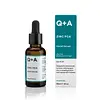What's inside
What's inside
 Key Ingredients
Key Ingredients

 Benefits
Benefits

 Concerns
Concerns

 Ingredients Side-by-side
Ingredients Side-by-side

Water
Skin ConditioningAloe Barbadensis Leaf Water
MaskingCucumis Sativus Fruit Water
Skin ConditioningPentylene Glycol
Skin ConditioningGlycerin
HumectantHydrolyzed Hyaluronic Acid
HumectantXanthan Gum
EmulsifyingRosa Damascena Flower Water
MaskingSodium Benzoate
MaskingSodium Hyaluronate
HumectantBenzyl Alcohol
PerfumingAlcohol
AntimicrobialBenzoic Acid
MaskingAloe Barbadensis Leaf Powder
Skin ConditioningBiosaccharide Gum-1
HumectantSodium Hydroxide
BufferingGlyceryl Caprylate
EmollientSorbic Acid
PreservativeSodium Anisate
AntimicrobialSodium Levulinate
Skin ConditioningCitric Acid
BufferingPotassium Sorbate
PreservativeWater, Aloe Barbadensis Leaf Water, Cucumis Sativus Fruit Water, Pentylene Glycol, Glycerin, Hydrolyzed Hyaluronic Acid, Xanthan Gum, Rosa Damascena Flower Water, Sodium Benzoate, Sodium Hyaluronate, Benzyl Alcohol, Alcohol, Benzoic Acid, Aloe Barbadensis Leaf Powder, Biosaccharide Gum-1, Sodium Hydroxide, Glyceryl Caprylate, Sorbic Acid, Sodium Anisate, Sodium Levulinate, Citric Acid, Potassium Sorbate
Water
Skin ConditioningPropylene Glycol
HumectantLactobacillus/Ganoderma Lucidum Extract/Lentinus Edodes Extract Ferment Filtrate
Skin ConditioningBetaine
HumectantPentylene Glycol
Skin ConditioningZinc PCA
HumectantLactobacillus Ferment
Skin ConditioningLonicera Caprifolium Extract
AstringentLonicera Japonica Callus Extract
Skin ProtectingLactic Acid
BufferingGlyceryl Caprylate
EmollientBiosaccharide Gum-1
HumectantCollagen
MoisturisingGlycerin
HumectantLeuconostoc/Radish Root Ferment Filtrate
AntimicrobialSodium Levulinate
Skin ConditioningSodium Anisate
AntimicrobialSodium Gluconate
Skin ConditioningXanthan Gum
EmulsifyingWater, Propylene Glycol, Lactobacillus/Ganoderma Lucidum Extract/Lentinus Edodes Extract Ferment Filtrate, Betaine, Pentylene Glycol, Zinc PCA, Lactobacillus Ferment, Lonicera Caprifolium Extract, Lonicera Japonica Callus Extract, Lactic Acid, Glyceryl Caprylate, Biosaccharide Gum-1, Collagen, Glycerin, Leuconostoc/Radish Root Ferment Filtrate, Sodium Levulinate, Sodium Anisate, Sodium Gluconate, Xanthan Gum
 Reviews
Reviews

Ingredients Explained
These ingredients are found in both products.
Ingredients higher up in an ingredient list are typically present in a larger amount.
Biosaccharide Gum-1 is a sugar created by fermenting sorbitol (which usually comes from potato starch!). It is known for its soothing and moisturizing properties.
Manufacturer tests show this ingredient helped reduce irritation from lactic acid by almost half and kept skin hydrated long-term as a humectant
Beyond hydration, Biosaccharide Gum-1 gives formulas a silky, non-sticky feel.
This ingredient is gentle, versatile, and suitable for all skin types.
Fun fact: Similar sugars can be found naturally in fruits like apples and pears.
Learn more about Biosaccharide Gum-1Glycerin is already naturally found in your skin. It helps moisturize and protect your skin.
A study from 2016 found glycerin to be more effective as a humectant than AHAs and hyaluronic acid.
As a humectant, it helps the skin stay hydrated by pulling moisture to your skin. The low molecular weight of glycerin allows it to pull moisture into the deeper layers of your skin.
Hydrated skin improves your skin barrier; Your skin barrier helps protect against irritants and bacteria.
Glycerin has also been found to have antimicrobial and antiviral properties. Due to these properties, glycerin is often used in wound and burn treatments.
In cosmetics, glycerin is usually derived from plants such as soybean or palm. However, it can also be sourced from animals, such as tallow or animal fat.
This ingredient is organic, colorless, odorless, and non-toxic.
Glycerin is the name for this ingredient in American English. British English uses Glycerol/Glycerine.
Learn more about GlycerinGlyceryl Caprylate comes from glycerin and caprylic acid, a fatty acid from coconut. It has emollient and emulsifier properties.
As an emollient, it helps hydrate your skin. Emollients work by creating a barrier on your skin to trap moisture in, helping to keep your skin soft and smooth.
On the other hand, emulsifiers prevent ingredients (such as oil and water) from separating.
Learn more about Glyceryl CaprylatePentylene glycol is typically used within a product to thicken it. It also adds a smooth, soft, and moisturizing feel to the product. It is naturally found in plants such as sugar beets.
The hydrophilic trait of Pentylene Glycol makes it a humectant. As a humectant, Pentylene Glycol helps draw moisture from the air to your skin. This can help keep your skin hydrated.
This property also makes Pentylene Glycol a great texture enhancer. It can also help thicken or stabilize a product.
Pentylene Glycol also acts as a mild preservative and helps to keep a product microbe-free.
Some people may experience mild eye and skin irritation from Pentylene Glycol. We always recommend speaking with a professional about using this ingredient in your routine.
Pentylene Glycol has a low molecular weight and is part of the 1,2-glycol family.
Learn more about Pentylene GlycolSodium Anisate comes from fennel. It is used as a preservative and to add flavoring.
Sodium Anisate has antimicrobial properties.
Sodium levulinate is the a sodium salt of Levulinic Acid. If dissolved in an aqueous solution, the two ingredients become identical.
It is a skin conditioning agent, meaning it helps soften and hydrate your skin.
According to Cosmetic Ingredient Review, the highest amounts of sodium levulinate are found in mouthwashes at 0.62%.
Learn more about Sodium LevulinateWater. It's the most common cosmetic ingredient of all. You'll usually see it at the top of ingredient lists, meaning that it makes up the largest part of the product.
So why is it so popular? Water most often acts as a solvent - this means that it helps dissolve other ingredients into the formulation.
You'll also recognize water as that liquid we all need to stay alive. If you see this, drink a glass of water. Stay hydrated!
Learn more about WaterXanthan gum is used as a stabilizer and thickener within cosmetic products. It helps give products a sticky, thick feeling - preventing them from being too runny.
On the technical side of things, xanthan gum is a polysaccharide - a combination consisting of multiple sugar molecules bonded together.
Xanthan gum is a pretty common and great ingredient. It is a natural, non-toxic, non-irritating ingredient that is also commonly used in food products.
Learn more about Xanthan Gum